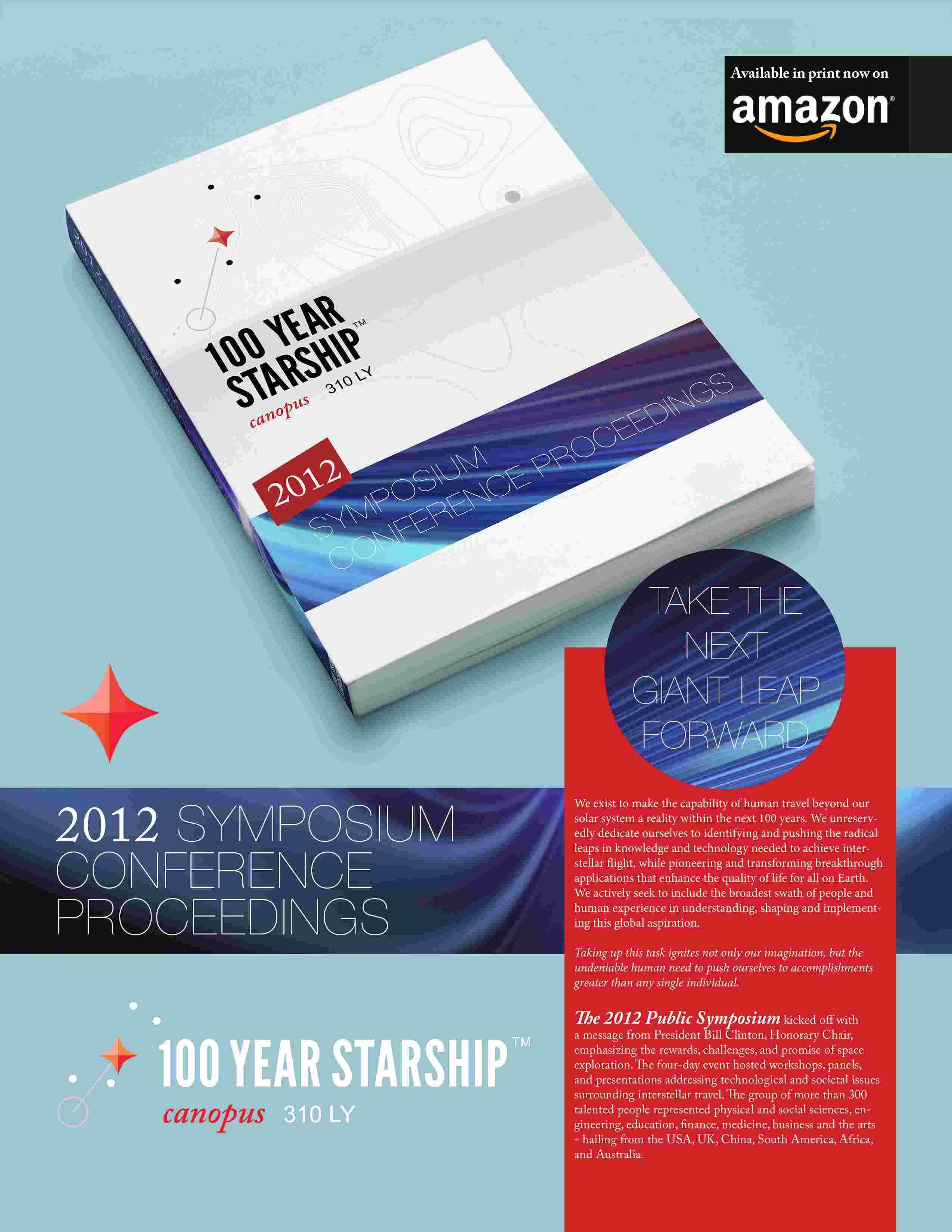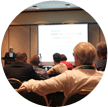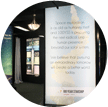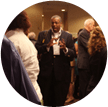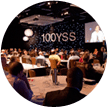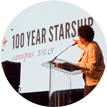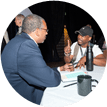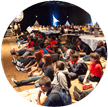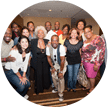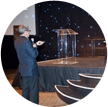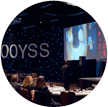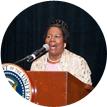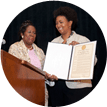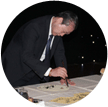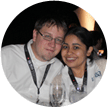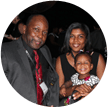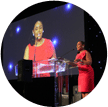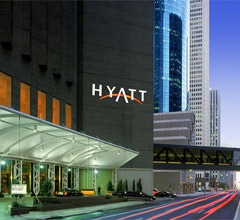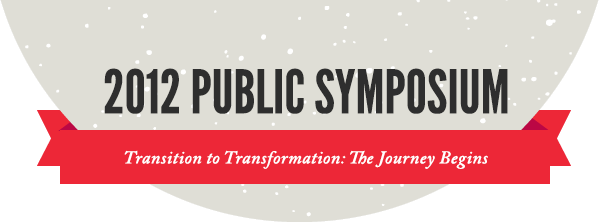
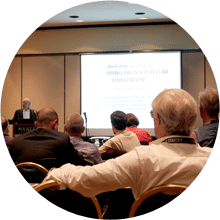
Speakers explore the complexities of Becoming an Interstellar Civilization.
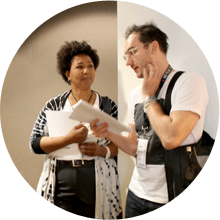
Dr. Mae Jemison and Benjamin Palmer discuss panel topics.
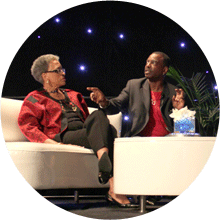
LeVar Burton and Dr. Johnnetta B. Cole discuss the effects of pop culture on space travel and vice versa.
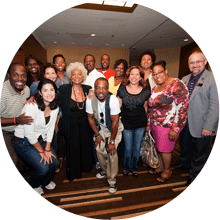
Educators at the workshops 2012 Public Symposium
The 2012 Public Symposium kicked off with a message from President Bill Clinton, Honorary Chair, emphasizing the rewards, challenges, and promise of space exploration. The four-day event hosted workshops, panels, and presentations addressing technological and societal issues surrounding interstellar travel. The group of more than 300 talented people represented physical and social sciences, engineering, education, finance, medicine, business and the arts - hailing from the USA, UK, China, South America, Africa, and Australia.
Panels
There were several presentation tracks, each being led by a distinguished and knowledgeable track chair.
Time-Distance Solutions
Chaired by Eric Davis, PhD
The vast distances that separate the stars pose profound challenges to the existing technologies and design paradigms used for both robotic and human space exploration in and around our solar system.
Read MoreLife: In Vivo and In Vitro — Earth to the Stars
Chaired by Ronke Olabisi, PhD
Whether a human or robotic mission, the life sciences are integral to interstellar exploration. Obvious concerns are crew health – physiological, psychological and spiritual – during the journey and upon arrival, as is the capacity to detect life.
Read MoreBecoming an Interstellar Civilization
Chaired by Ian O'Neil, PhD
Our society has changed in extraordinary ways since Sputnik was launched in 1957 and the challenge to send humans to the Moon was issued in 1961. Long held social and cultural beliefs had to expand to accommodate the implications of the new knowledge and figurative and literal perspectives gained.
Read MoreDestinations and Habitats
Chaired by Joe Ritter, Phd.
Papers in this track are invited to offer strategies, techniques, processes and solutions that address the needs of special habitats (on the journey and at the destination), especially as they contrast to today's space infrastructure.
Read MoreSpecial Sessions
A. College Track
Chaired by David Alexander, PhD.
College undergraduates and high school seniors are invited to present papers on any of the topics of the Symposium technical tracks during this session. Or, students are called to imagine how their lifetime would differ with or without a global interstellar ambition.
B. Interstellar Enhances Life on Earth
Chaired by Fola Soares, PhD
Session invites papers on new/novel current or proposed applications of space technologies, interstellar disciplines, research and knowledge to enhancing and understanding life on Earth.C. Interstellar Aspiration — Commercial Perspiration: The Next 30 Years of Space Start-ups and Commercialization
Co-Chaired by Amy Milliman and Dan Hansen
From weather satellites to GPS to high temperature, low-density materials, space technologies touch our lives every day. And now entrepreneurs are offering space itself as an industry. This session will include current and potential commercial space technology and exploration businesses over the next 30 years. Papers should consider business and technology innovations spanning several years, strategies funding, and creating new markets in space and on Earth.
selected papers & presentations
Warp Field Mechanics
Harold White, PhD NASA Johnson Space Center
The Nuclear Option: The Feasibility of Transport of an Interstellar Target within a single human lifetime
Jim Caver, AIM-USA
Near Term Commercial Space Infrastructure Colonization
Keith Taggert, et al, Spec Innovations
Key Issues for the design of Habitable Extraterrestrial Structures
Haym Benaroya, PhD, Rutgers University
Role of Gameplay in Space
Mellissa Patton
A User Friendly Graphical Interface for Simulating Galactic Stellar Populations
Alexander Bailey Howard
The Starship Singularity
Gabriel Rothblatt, Terasem
Whole Brain Emulation: Feasibility and Design Considerations
Greg Fleetwood, Space Colony Earth
Sustainability as a Criteria
David Haberman, IF LLC
Viable Interstellar Economies for the Collective Good
Gordon Gould
SERVIR: a space-based remote sensing for land management
Dan Irwin, NASA
Considering Clothing and Textiles on an Interstellar mission
Karl Aspelund, PhD, University of Rhode Island
Distinguished Speakers & Guests
Mae Jemison
Leader, 100 Year Starship
LeVar Burton
Actor
Nichelle Nichols
Actress
Annise Parker
Mayor
Sheila Jackson Lee
Congresswoman
Miles O'Brien
Journalist
Dr. Jill Tarter
Director, SETI Institute
Dr. Johnnetta B. Cole
Director, Smithsonian Museum of African Art
Zhang Wenxiang
China National Calligrapher
Benjamin Palmer
CEO, The Barbarian Group
Dr. Ellen Ochoa
Deputy Director, NASA’s Johnson Space Center
Stephanie Wilson
Astronaut
Frank Hughes
50-year NASA veteran engineer
Dr. Linda Wetzel, Professor
George Washington University
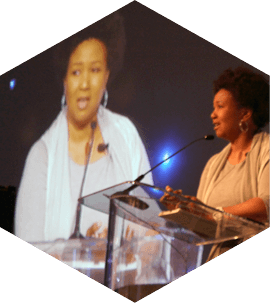
A Note From Dr. J
“[The challenge of human interstellar travel is] more than a propulsion problem, more than an engineering problem. There are incredibly difficult social and cultural questions to answer as we go. [...]. Where are we going? Who gets to go? And what do we do when we get there? And most importantly, how does it benefit the people on earth? For the last few decades, astronauts and rocket scientists have been the face of space exploration but they weren’t the only ones making it happen. [...]. Achieving the capabilities for travel to another solar system will require a global, collaborative effort.”
sponsors
- Scholastic, Inc.
- The Barbarian Group
- Pfizer, Inc.
- The Studio NYC
- Houston Museum of Natural Science
- United Airlines
- Rice University
- The Jemison Group, Inc.
- NASA
- Greater Houston Convention and Visitor's Bureau
- Greater Houston Partnership
- Houston Independent School District
- Music World Entertainment
- Hiram Dallas
- Prophet
*Image courtesy of NASA/JPL

